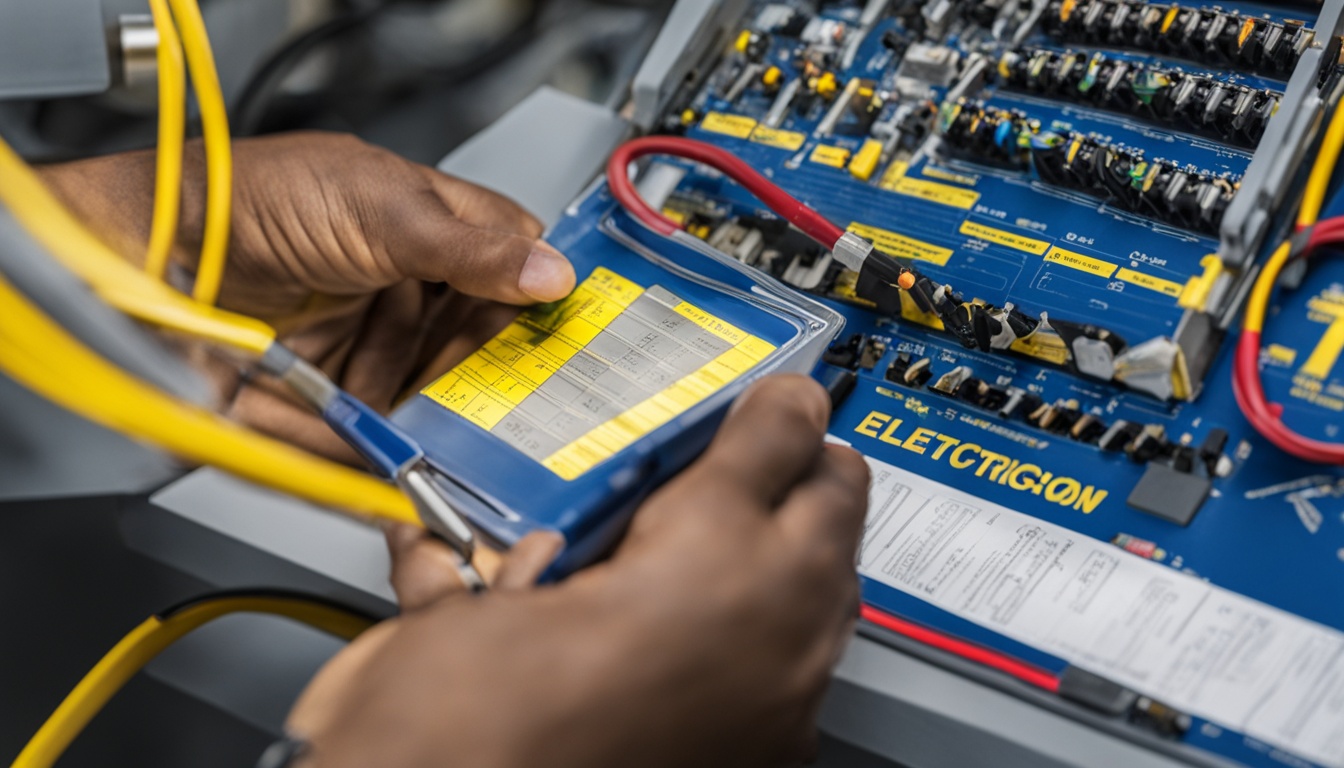Did you know 72% of contractors using specialized tools report completing 30% more jobs monthly? This surge in productivity isn’t magic—it’s the power of integrated platforms reshaping how teams handle daily tasks. For businesses juggling schedules, invoices, and client demands, modern systems cut through the chaos like never before.
Imagine a tool that syncs your field teams, back-office staff, and clients in real time. Platforms like ServiceTitan reveal contractors using unified solutions boost revenue by 25% annually. How? By automating repetitive tasks, slashing paperwork, and delivering faster service.
These systems aren’t just about speed. They enhance client trust through instant updates and transparent communication. Picture customers approving quotes digitally or tracking project timelines via self-service portals. It’s professional, efficient, and builds lasting loyalty.

Key Takeaways
- Integrated tools reduce manual work by automating job scheduling and invoicing.
- Real-time GPS tracking improves team coordination and on-time arrivals.
- Centralized customer portals increase transparency and satisfaction.
- Automated workflows cut administrative costs by up to 40%.
- Unified platforms help businesses scale without adding overhead.
Forget clunky spreadsheets and missed calls. Today’s solutions let contractors focus on growth, not paperwork. Ready to see how your team could thrive with smarter workflows?
Introduction to Modern Electrical Work Orders
The shift from paper forms to digital workflows has revolutionized how contractors operate. Today’s work orders are dynamic tools that track progress, allocate resources, and keep clients informed—all in real time. This evolution mirrors broader industry changes, where speed and transparency define success.
Understanding the Evolving Industry
Gone are the days of handwritten job tickets and endless phone tag. Platforms like Orderry and BuildOps now power modern contracting teams. These systems combine GPS tracking, automated scheduling, and mobile updates to cut delays. For example, one provider reduced client wait times by 50% using live technician routing.
This digital-first era prioritizes adaptability. Contractors using integrated tools report 28% fewer scheduling conflicts. Real-time data syncs eliminate guesswork, letting teams focus on quality outcomes instead of administrative chaos.
Why Efficiency Matters Now
Fast response times aren’t just convenient—they build trust. When customers see instant updates via self-service portals, satisfaction spikes. A study showed firms using task management tools retained 35% more clients annually.
Specialized solutions also slash operational costs. Automated dispatching reduces fuel waste, while digital invoicing speeds up payments. One electrician service software user cut billing errors by 90%, freeing hours weekly for proactive customer outreach.
These advancements set the stage for deeper dives into technical features. Next, we’ll explore how unified platforms turn fragmented processes into competitive advantages.
Electrical Work Management Software
In today’s fast-paced contracting world, staying ahead means embracing tools that do more than just track jobs. Specialized platforms combine scheduling, inventory oversight, and live updates into one cohesive system. For example, electrician service solutions like ServiceTitan sync crew locations with client demands, cutting delays before they start.
These systems shine by tackling three core needs. First, automated dispatching assigns tasks based on proximity and skill levels. Second, real-time stock alerts prevent mid-job shortages. Third, mobile apps let technicians update job statuses instantly—no paperwork shuffle.
For electrical contractors, this integration means fewer headaches. Office teams generate invoices while field crews handle installations, with data flowing seamlessly between both. One user reported 45% faster billing cycles after adopting such tools.
The entire team benefits from shared visibility. Dispatchers monitor progress dashboards, while accountants access payment histories. Field staff receive instant alerts about schedule changes or material deliveries. Everyone stays aligned without endless check-ins.
Effective management tools also foster clearer client conversations. When customers see live timelines or approve quotes digitally, trust grows naturally. These interactions lay groundwork for recurring business—a win for long-term growth.
Up next, we’ll break down how advanced features like predictive analytics take these efficiencies even further.
Streamlining Operations with Field Service Management Tools
What separates top-performing contractors from the rest? Often, it’s their ability to unify scattered processes into a single command center. Modern platforms merge scheduling, dispatching, and client communication tools—turning chaos into coordinated action.
Centralizing Workflows for Better Efficiency
Imagine your crew receiving instant job updates while en route. Orderry’s mobile app does exactly this, syncing real-time data across teams. Technicians access customer histories, inventory levels, and route maps without calling the office.
Centralized scheduling cuts wasted hours. Dispatchers assign jobs based on location and expertise, reducing drive times by 22% for some users. Alerts notify teams about delays or material shortages before they escalate.
Back-office integration keeps everyone aligned. Invoices generate automatically as field crews complete tasks, with payments syncing to accounting systems like QuickBooks. One contractor slashed billing errors by 78% using this approach.
Real-time alerts transform responsiveness. Customers get ETAs via text, while managers monitor progress dashboards. These features prepare businesses for deeper dives into advanced tools—like predictive analytics—covered next.
Key Features of Effective Electrical Contractor Software
At the core of every high-performing contracting team lies a system that turns complexity into clarity. Modern platforms blend critical tools to handle everything from initial quotes to final payments, creating a frictionless workflow for crews and clients alike.
Scheduling and Dispatch Capabilities
Smart scheduling tools analyze technician locations, skills, and traffic patterns. Orderry’s GPS routing slashes drive times by 18% for many users. Dispatchers see real-time updates on crew availability, while automated alerts notify customers about arrival windows.
Live dashboards prevent double-booking. If a job runs long, the system reshuffles appointments instantly. One contractor reported 40% fewer missed appointments after adopting this feature.
Estimation and Invoicing Integration
Orderry’s multi-option estimate builder lets teams create detailed quotes in minutes. When clients approve digitally, the platform auto-generates work orders—no manual data entry. This cuts proposal-to-job time by 65% for some businesses.
Integrated billing syncs with accounting tools like QuickBooks. Technicians trigger invoices upon job completion, reducing payment delays. A Midwest electrical company saw 90% faster payments using this approach.
These features eliminate duplicate entries and keep field-office communication airtight. Next, we’ll explore how mobile tools amplify these efficiencies for on-site crews.
Enhancing Technical Team Productivity
Mobile technology is transforming how field teams operate—putting critical tools directly in their toolbelts. With apps like ServiceTitan’s solution, technicians access everything from blueprints to billing history before stepping onto a job site. This instant access eliminates guesswork and keeps crews focused on quality results.
Power in Your Pocket
Real-time updates keep office and field teams aligned. Dispatchers adjust schedules instantly when traffic hits, while technicians send photo updates mid-job. One contractor using Fieldwire reclaimed 6+ hours weekly by cutting check-in calls.
Digital invoicing slashes paperwork delays. Crews trigger payments on-site, syncing data with accounting systems automatically. A Texas company reduced billing errors by 88% using this approach.
Error-free payroll management boosts morale. Hours logged via mobile sync directly with payroll systems, ensuring accurate compensation. This transparency builds trust within teams and with clients.
Customers notice the difference too. Real-time ETAs and photo updates via service apps create professional impressions. One firm saw 32% more five-star reviews after adopting mobile tools.
These mobile advantages set the stage for deeper client relationships. Next, we’ll explore how integrated communication tools take customer experiences even further.
Optimizing Customer Management and Communication
Ever wonder how top contractors turn one-time jobs into lifelong clients? The secret lies in blending smart tech with human-centric service. Modern platforms now merge customer data, service history, and instant updates—creating experiences that keep clients coming back.
CRM Integration and Automated Alerts
BuildOps’ customer portals show how integrated tools strengthen relationships. When work orders sync with CRM systems, contractors track every interaction—from initial calls to post-job surveys. This history helps teams personalize future service, like reminding customers about annual inspections.
Automated alerts keep everyone in sync. Technicians receive instant job updates via mobile app, while customers get ETAs via text. One Florida electrical contractor reduced missed appointments by 45% using these notifications.
Centralized data transforms follow-ups. Instead of digging through emails, teams view complete service histories at a glance. This speeds up troubleshooting—like identifying recurring issues from past jobs. BuildOps users report 60% faster resolution times for repeat service requests.
Real-world results prove the value. A Texas electrical contracting business boosted customer satisfaction scores by 33% after implementing live GPS tracking alerts. Clients appreciated seeing technician locations and revised arrival times during storms.
These tools bridge field operations and client care seamlessly. When technicians update job statuses, CRM systems trigger thank-you emails and feedback surveys automatically. It’s professional service that feels personal—exactly what builds lasting trust.
Integrating Estimation, Reporting, and Payment Systems
What if your estimates could transform into invoices without lifting a finger? Platforms like Orderry make this possible by connecting every financial touchpoint. When a client approves a digital proposal, the system instantly generates work orders and tracks progress—all while updating your books.
From Proposal to Payment: A Seamless Process
Orderry’s tools turn estimates into action. Teams create detailed quotes using pre-loaded templates, then share them via email or customer portals. Approved proposals auto-convert into scheduled jobs, eliminating manual data entry. One Arizona business cut payment delays by 60% using this approach.
Automation keeps office teams and field crews aligned. Completed jobs trigger instant invoices synced with QuickBooks, while real-time dashboards show unpaid balances. Technicians log materials used directly through mobile apps, ensuring accurate billing. This eliminates spreadsheet errors and speeds up payroll processing.
Financial transparency builds trust internally and externally. Contractor software stores every transaction in searchable cloud records—no more lost paperwork. Managers spot profit trends faster, while accountants reconcile payments effortlessly. For electrical contractor software users, this clarity often leads to 25% fewer billing disputes.
These integrated systems prepare teams for smarter project oversight. With financial workflows humming smoothly, businesses can focus on optimizing job execution—the focus of our next section.
Managing Projects and Work Orders Efficiently
How do leading contractors handle 50+ projects without missing a beat? Platforms like BuildOps and ServiceTitan consolidate every detail—from material lists to client notes—into a single dashboard. This centralized approach turns chaotic job tracking into organized progress.
Digital work orders eliminate paper trails. Technicians update task statuses via mobile app, syncing instantly with office systems. One contractor using ServiceTitan reduced documentation errors by 74% while cutting admin hours weekly.
Real-time updates keep everyone aligned. Dispatchers see live job progress, while customers get automated ETA texts. A Midwest business reported 40% faster project completion after adopting these alerts. Field crews access blueprints and inventory levels on-site, preventing costly return trips.
Electrician software drives smarter oversight. ServiceTitan users spot bottlenecks through color-coded timelines—like rescheduling delayed tasks in two clicks. BuildOps’ reporting tools help electrical contractor teams analyze profit margins per job type.
These tools also prep your business for growth. Automated workflows handle repeat clients’ maintenance schedules, freeing staff for complex projects. Next, we’ll explore how tracking tools keep your resources—not just schedules—running smoothly.
Inventory and Equipment Tracking for Electrical Contractors
What’s the secret sauce for contractors who never run out of supplies mid-job? Smart tracking systems that treat tools and materials like precious cargo. Platforms like Orderry turn chaotic stockrooms into organized digital warehouses—where every wire nut and circuit tester gets accounted for.
Monitoring Stock Levels and Consumption
Real-time alerts prevent “out-of-stock” surprises. QR codes on equipment boxes sync with mobile apps, updating inventory counts instantly. BLE tags track high-value tools across job sites, showing exactly who checked out that voltage tester last Tuesday.
Integrated accounting slashes shortages. When materials get assigned to work orders, the system deducts them from digital shelves automatically. This syncs with procurement lists, ensuring trucks restock before the next job. One Midwest team cut emergency supply runs by 70% using this approach.
Field crews stay equipped without guesswork. Mobile apps show exact tool locations and expiration dates for safety gear. Orderry users report 80% fewer “forgotten tool” delays—critical when racing against project deadlines.

These systems also boost client trust. Imagine sending a photo of installed materials directly from the electrician software interface. Customers see transparency, while contractors maintain audit-ready records. A Texas firm reduced billing disputes by 55% after adopting live inventory tracking.
With supplies flowing smoothly, teams can shift focus to perfecting their next move: razor-sharp scheduling.
Optimizing Dispatch and Scheduling with Real-Time Data
What if dispatchers could spot scheduling conflicts before they derail your day? Modern platforms like BuildOps turn this vision into reality through live dashboards that track every moving part. Real-time updates show technician locations, job progress, and inventory levels—all updating minute by minute.
Utilizing Dispatch Dashboards and Alerts
Imagine a map glowing with technician icons and color-coded jobs. Dispatchers using BuildOps can drag appointments across a digital map, instantly seeing drive-time changes. Alerts pop up when two jobs overlap geographically or exceed a crew’s skill level.
These systems prevent 3pm chaos. If a bathroom rewire runs long, the dashboard automatically flags affected appointments. Dispatchers reshuffle schedules in two clicks, sending revised ETAs via text. One Maryland contractor reduced last-minute scrambles by 58% using these alerts.
Reducing Overlap and Downtime
Skills-based scheduling ensures the right person handles each task. A commercial panel upgrade goes to certified experts, while apprentices handle routine maintenance. This precision cut travel time by 19% for an Orderry user in Ohio.
Real-time data slashes windshield time too. ServiceTrade’s routing tool groups nearby jobs automatically, even accounting for traffic. Teams complete 2-3 extra tasks daily without rushing—a 27% productivity boost for some businesses.
This smarter coordination doesn’t just save hours. Clients notice smoother operations when technicians arrive prepared, not frazzled. One Florida contractor saw 41% more five-star reviews after implementing live dispatch tools.
As these efficiencies compound, teams naturally look toward unified platforms that connect every operational thread—the focus of our next exploration.
Benefits of a Unified Software Platform
Imagine replacing seven disconnected apps with one command center that handles every aspect of your contracting business. Platforms like ServiceTitan and Orderry merge scheduling, job tracking, and financial tools into a single dashboard. This integration slashes errors caused by manual data transfers between systems.
Unified platforms simplify complex workflows. Teams update project statuses once, and changes reflect everywhere—from inventory lists to client invoices. McKinsey found companies using integrated systems reduce operational costs by 20% while boosting productivity.
Financial control improves dramatically. Automated invoicing syncs with accounting software, cutting payment delays by 60% for Bath Boys. Real-time profit dashboards help businesses spot trends faster, like which services yield the highest margins.
Rocky Mountain Solar Co. grew 30% after adopting a unified system. Their teams tracked materials, crew hours, and client communications through one interface. This visibility lets managers make data-driven decisions instead of guessing.
With all tools in one place, reporting becomes effortless. Ontraccr users generate compliance documents or tax records in two clicks. These efficiencies set the stage for smarter comparisons between industry-leading solutions—our next focus.
Comparing Industry-Leading Solutions
The field service tech market buzzes with options, but not every platform fits all contractors. Three heavyweights—ServiceTitan, Orderry, and BuildOps—each tackle unique challenges. Let’s unpack their specialties to find your perfect match.
ServiceTitan: Residential Powerhouse
ServiceTitan shines for home-focused teams needing live crew tracking. Its cloud-based tools help midsize businesses monitor technicians’ locations and job progress seamlessly. Integrated estimating slashes quote creation time, though new users report a learning curve.
Residential contractors praise the mobile invoicing feature. One Phoenix team cut payment delays by 50% using instant digital bills. Real-time dispatch keeps clients informed via automated texts—ideal for unpredictable service windows.
Orderry vs BuildOps: Flexibility Defined
Orderry offers a Swiss Army knife approach. Its reporting tools track everything from inventory use to profit margins. Commercial teams benefit from custom workflows that adapt to complex projects. One industrial contractor boosted project completion rates by 38% using its modular design.
BuildOps targets larger operations needing airtight communication. Its proposal builder and field app sync office teams with technicians instantly. A New Jersey contractor reduced miscommunications by 62% using its unified message threads.
Choosing depends on your focus: ServiceTitan for residential agility, BuildOps for enterprise-scale coordination, Orderry for growing businesses craving customization. All three eliminate spreadsheet chaos—pick the one aligning with your next growth leap.
Boosting Revenue and Customer Satisfaction
What separates thriving contractors from struggling ones? Often, it’s their ability to turn raw numbers into actionable strategies. Platforms like ServiceTitan and BuildOps transform historical job data into growth engines—helping teams earn more while keeping clients loyal.
ServiceTitan users report 30% more repeat business by analyzing service history. Teams review past projects to spot trends—like seasonal demand spikes or common client requests. This insight lets them schedule preventive maintenance reminders, creating steady revenue streams.
Leveraging Data for Business Growth
BuildOps clients boost average ticket sizes by 22% using upsell recommendations. The system flags opportunities based on job types—like suggesting panel upgrades during routine inspections. Customers appreciate proactive solutions, while contractors enjoy higher margins.
Real-time dashboards simplify financial tracking. One Midwest team cut unpaid invoices by 65% using automated payment reminders synced with QuickBooks. Clear profit reports help managers reinvest savings into training or marketing.
Unified platforms also strengthen client trust. When customers receive personalized service summaries via email, satisfaction scores climb. A Florida contractor using software electrical contractors rely on saw 40% more five-star reviews after sharing data-driven project timelines.
These insights become your compass for selecting tools that align with growth goals. Next, we’ll break down how to match features with your team’s unique needs.
How to Choose the Right Electrical Contractor Software
What’s the first move when hunting for tools that fit like a glove? Start by mapping your daily pain points. Do missed appointments drain productivity? Are billing errors eating profits? List these challenges to pinpoint must-have features.
Assessing Your Business Needs
Dispatch tools make or break efficiency. Look for platforms offering live technician tracking and route optimization. Fieldwire’s mobile app lets crews update job statuses instantly—no more radio silence between sites.

Integration with accounting systems like QuickBooks slashes duplicate data entry. Method:Field Services syncs invoices and payments automatically, cutting billing delays by 60% for some teams. Test compatibility during free trials to avoid surprises.
User experience matters more than flashy features. Can your least tech-savvy employee navigate the interface? Powered Now’s route planner and Thryv’s client portals prioritize simplicity. Check if providers offer onboarding support—responsive training often separates good solutions from great ones.
Compare apples to apples. Create a scorecard rating scalability, security, and real-time reporting. Procore excels at complex project oversight, while STACK simplifies estimates. The right software electrical contractors trust adapts as you grow—setting the stage for real-world success stories ahead.
Real-World Case Studies and Success Stories
Behind every thriving contractor is a story of smart tech adoption. Let’s explore how teams nationwide transformed chaos into clarity—and what you can learn from their journeys.
Lessons from Residential and Commercial Installations
ServiceTitan helped a Phoenix residential team slash payment delays by 50% using mobile invoices. Their automated alerts reduced missed appointments by 45%, while real-time reporting tools uncovered $12K in monthly savings opportunities.
Orderry reshaped commercial workflows for a Midwest contractor. Live inventory tracking cut emergency supply runs by 70%, and GPS routing boosted on-time arrivals to 94%. “Our project timelines tightened by 18% immediately,” their operations lead noted.
Testimonials from Industry Leaders
Jason McCarty of Rosendin Electric credits structured software electrical contractors use with 30% faster project execution. “Our field leaders now resolve issues in half the time using centralized dashboards,” he shares.
BuildOps user Rocky Mountain Solar Co. grew revenue by 25% annually after adopting their platform. “We track every job detail in one place—no more chasing paper trails,” their CEO explains. Teams now complete 2-3 extra tasks per day using optimized dispatch tools.
These stories prove that measurable gains aren’t theoretical. When tools align with real-world needs, businesses unlock new levels of efficiency and trust.
Conclusion
Proven results from industry leaders like ServiceTitan and BuildOps show unified platforms transform operations. Teams using these solutions slash admin hours while boosting client trust through real-time updates and digital invoices.
Key features drive measurable gains. Automated dispatch cuts travel time, while integration with tools like QuickBooks ensures error-free billing. Centralized dashboards give managers instant visibility into project progress and profit margins.
Success stories reveal patterns. One Arizona team using Orderry reduced payment delays by 60% through mobile invoicing. Another firm using BuildOps saw 40% faster project completion after adopting live scheduling alerts.
The right solution matches your workflow needs. Evaluate platforms offering free trials to test mobile access, customer portals, and reporting tools. Prioritize systems that grow with your business—like those trusted by top software electrical contractors.
Ready to simplify your day? Contact providers for personalized demos and discover how modern tools can turn operational headaches into competitive advantages.
See how FieldAx can transform your Field Operations.
Try it today! Book Demo
You are one click away from your customized FieldAx Demo!
FAQ
How does field service management software improve efficiency for electrical teams?
Centralizing workflows through tools like scheduling dashboards and mobile apps reduces manual tasks. Real-time updates keep crews aligned, cutting downtime and speeding up job completion.
What features should I prioritize in contractor software for my business?
Look for integrated scheduling, dispatch automation, and QuickBooks sync for invoicing. Mobile access for on-site teams and CRM tools for customer alerts also boost productivity.
Can these platforms help with inventory tracking?
Yes! Solutions like ServiceTitan or Orderry monitor stock levels, track equipment usage, and send alerts for restocking. This prevents delays and keeps projects on budget.
How do mobile apps benefit technicians in the field?
Apps provide instant access to job details, client history, and parts lists. They also enable digital signatures, photo uploads, and real-time communication with the office.
Why is CRM integration important for customer satisfaction?
Automated alerts, service reminders, and centralized client data ensure timely follow-ups. This builds trust and encourages repeat business through personalized interactions.
How does real-time data optimize dispatch and scheduling?
Live dashboards show crew locations, job progress, and traffic updates. Dispatchers can reroute teams to avoid overlap, reducing fuel costs and maximizing billable hours.
What role does reporting play in growing an electrical contracting business?
Detailed reports on revenue, job costs, and team performance highlight trends. Use this data to adjust pricing, allocate resources, and target high-profit services.
How do estimation tools integrate with payment systems?
Platforms like BuildOps let you create quotes, convert them to invoices, and accept payments online. QuickBooks integration ensures seamless accounting without double-entry work.
What factors matter most when choosing contractor software?
Prioritize ease of use, scalability, and customer support. Test demos to ensure the platform aligns with your workflows—whether residential repairs or large commercial projects.
Can these solutions reduce administrative tasks for small businesses?
Absolutely! Automated work orders, digital invoicing, and AI-driven scheduling free up hours each week. This lets owners focus on growth instead of paperwork.
Author Bio
Co-Founder & CMO at Merfantz Technologies Pvt Ltd | Marketing Manager for FieldAx Field Service Software | Salesforce All-Star Ranger and Community Contributor | Salesforce Content Creation for Knowledge Sharing






